Vegan Teacher Fired for Facebook Post Pens New Book
Disclosure: This post may contain affiliate links
Keith Allison sits down with Your Daily Vegan to talk about his new book, What if the Shoe Were on the Other Hoof?

What's in this post
Compassion advocate and educator Keith Allison took the time to talk with me about his new book, What if the Shoe Were on the Other Hoof? If Allison’s name sounds familiar, it’s because he made national news last year when he filed a lawsuit against his former school district employer for being removed from his position as an elementary school tutor as a result of sharing his vegan beliefs on Facebook.
Allison, who then worked for the Green Local School District based in Ohio, filed suit against his former employer, stating he was fired after school administrators found Facebook posts he made about baby calves in small calf hutches. These posts, shared on his personal Facebook account, made reference to the inherent cruelty inside every glass of milk, saying:
“the cruelty of separation, loneliness, an infant slaughter lingers inside each glass of cow’s milk. Your voice can change the system. You don’t have to support this. Plant-based milks are everywhere and are delicious.”
According to the lawsuit, once the school’s administration discovered the post about the calves, the superintendent and principle met with Mr. Allison, saying the community “had a large number of dairy farmers, and that teachers needed to be careful not to offend the local agricultural industry.” He was subsequently fired. After Allison was terminated, his situation was made public and garnered attention and support from advocates across the country. A petition on change.org urging the school board to reinstate the teacher’s job received over 139,000 signatures. Allison later reached a settlement with the school district.
The experience ignited and deepened Allison’s commitment to the animals. Allison is now an educator for the Ethical Choices Program– a program which aims to empower high-school students to make thoughtful, responsible lifestyle decisions. They examine issues related to modern agriculture and its impact on the environment, our health, and farmed animals.

He has also penned a new book that shines a light into the dark shadows of modern day animal agriculture, exposing something that the industry wishes we would forget- animals matter. What if the Shoe Were on the Other Hoof? is a poignant examination of the fundamental truth about all of us: none of us want to hurt animals. So why do we? The answer to this question requires us to re-evaluate our most deeply-held beliefs about using animals. Allison shows how to widen our view and build upon the compassion that we all inherently possess. Engaging and filled with complexity, What if the Shoe Were on the Other Hoof? is the book you share and wait for the conversations to follow. Because they will. This book is a conversation starter.
I invited Keith to sit down with me and tell me a little more about his new book.
KD: Can you talk a little bit about why you decided to write the book? Was it a specific incident?
KEITH ALLISON: I first envisioned this project as a small pamphlet that I could hand out to people when I was tabling at an event. I had some writing and artwork that I was really excited about and wanted to share, and this seemed like a good way. As I started going through my hard drive, looking for saved files to choose from, I found I had saved far more than I realized. What I imagined to be a twenty page project kept growing until it was clear that this was going to be a book, not a pamphlet. The act of putting this book together also inspired me to write and draw more. It was a very productive period of creation for me, which of course, extended the book even further.
KD: What are you trying to achieve by writing the book- what is the message in your book that you hope readers will grasp?
KEITH ALLISON: My goal is to raise awareness and start conversations because I truly believe that it is not a radical concept to not want to cause harm to others. Since we all, deep down, share so many of these values (not wanting to cause harm, wanting to protect our environment, wanting to feed the hungry), when we have legitimate dialogue with each other, there is a great window to awareness and change that we can help open. I hope my book inspires those kinds of conversations, where we look at changes that may not seem comfortable, because those kinds of changes are the ones that can make the most impact.
I hope my book reaches the hands of meat eaters and vegetarians and they allow themselves to be drawn in and openly examine their own thoughts and values and how their actions can best match those values. I also hope it reaches and inspires vegans, recharging and empowering their own voices as they strive to use their voices to improve the world.
KD: Was there anything that you left out of the final draft or anything that you wish you had covered, but didn’t?
KEITH ALLISON: When initially going through my saved writings on veganism from the past four years, there were a few things that I skipped over and never considered for the book. Everything that was given serious consideration, however, ended up making the book. I did debate on whether to include a couple essays. One was a new essay that I wrote on how people always seem to blame deer for hitting their car; examining the very language we use to describe the incident, “A deer hit me,” and how this language would never transfer to a collision with a human. I didn’t think the essay would resonate with meat eaters and, for that reason, I considered leaving it out. But, I thought it would resonate well with vegans and, as this book is for them too, I eventually decided to leave it in. The other item was a short speech I had given for the Akron Peace Project on our vegan mentoring program. Some of the context was gone, removing it from the event itself. To help with that, I dropped the last paragraph, but the rest of the speech stayed in.
At the moment, there is nothing I wish my book would have covered but didn’t. I imagine that will change soon and new essays and artwork will come to me too late. That will give me a good reason to write another book though.
KD: Let’s talk a little about the art that is included in the book and the inspiration and thought process behind your work. What inspired you to use art as activism? Do you have a favorite piece?
KEITH ALLISON: My first use of art as activism came clearly into my mind within a few days of becoming vegan. I felt like these walls I allowed had tumbled down and I saw things in a new light and it really changed my outlook in ways that I couldn’t even consciously describe yet. There I was lying in bed and envisioning a dairy farm but, with my new understanding of all that was necessary to bring cow’s milk to humans, my mind reversed the roles. I saw a cow sitting at a desk, reading a newspaper and drinking coffee, as female humans were hooked to machines so their milk could be taken and sold for profit. Sometimes artwork can speak in ways that words can’t. I had only been a vegan for a few days, and wouldn’t have even called myself an activist yet, I just knew I needed to share these thoughts through art. The only part of the drawing that wasn’t in that initial vision in my sleepy mind was the top left corner. As I was drawing, that final piece came to me. Just like the unwanted baby cows of the dairy industry, as pregnancy is necessary for milk production, there would be unwanted baby humans in this reversed illustration. Even the title for this piece, which would eventually become the title for my book, was in my mind from the start. The title inspired other reversals, such as the fish pulling a human underwater, hooked on his fishing rod, and I continued to draw.
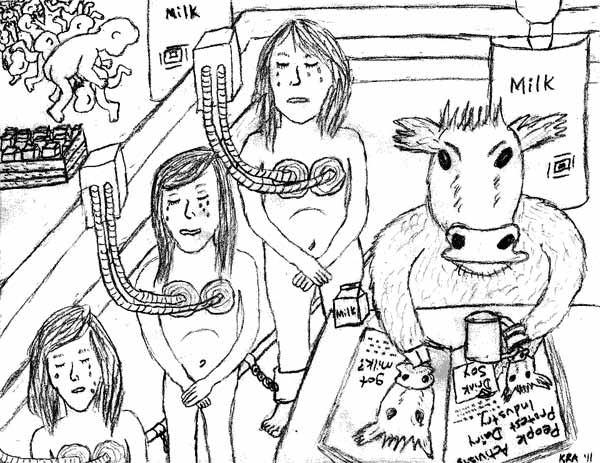
What if the Shoe were on the Other Hoof? Original art by Keith Allison, 2011
Sometimes the images come to me clearly, ready to be drawn, and sometimes my artwork is a result of wanting to address a statement someone makes, such as “it is so expensive to be vegan.” Although I love words, there are times where art can show things so simply and powerfully.
I think that very first drawing of humans being milked remains my favorite; both because of its role in my realizing that I had unintentionally become an activist and in the power of the image itself. We try to tell ourselves that the things we are doing are perfectly fine and humane, but when we view ourselves from the position of the animals, humane is the last word we would accept to describe it.
My next closest to a favorite is a recent drawing called “I Can’t Watch.” I wanted to address how we are always told that eating meat is so normal and natural and yet people turn away from slaughter. How natural can it be if we have to avert our eyes? I took the animal that people always seem to use when connecting humans to the animal kingdom as a way to prove or justify our desire to eat other animals: the lion. I placed the lion at a dinner table with a zebra steak sitting on a plate in front of him beside his knife, fork, and spoon. The television is on, however, and on comes this segment “slaughterhouse exposed” with zebras hanging from hooks for slaughter. The lion has to cover his eyes. He can’t allow himself to witness what took place to bring this steak to his plate, because that is the role the humans have placed themselves in; which, despite what they tell themselves, bears no resemblance to the role of a lion. Part of what I like so much about this drawing is how it evolved. There was this dead space to the right of the television and I knew I had to put something there, but I hadn’t planned to need anything else. Looking around my room, I decided an arm chair would be a decent use of the space. It wasn’t until I had finished drawing the chair that it became clear. Of course! The chair should be made of zebra leather. What is now my favorite part of the drawing was simply a happy accident from trying to fill in empty space.
KD: What was the hardest thing about writing about veganism?
KEITH ALLISION: For me, the hardest thing about writing about veganism is finding the time to respond to those that speak up in disagreement. You have to accept when you say or post things promoting veganism, that there will be disagreement and those who want to dismiss your words. But engaging in conversation is crucial to changing minds so I welcome legitimate questions and dialogue. I just know that the time it takes to write something is only part of the time involved.
KD: That is something that I find difficult too. I want to give everyone ample time to talk about the issues that are most important to them, but finding the time for it all can be complicated. Are there any vegan books that have influenced you or your writing style?
KEITH ALLISON: There were several books that really spoke to me when I first came to them as a new vegan: The 30-Day Vegan Challenge by Colleen Patrick-Goudreau, The Food Revolution by John Robbins, and Mad Cowboy by Howard Lyman were among them. I think I have been influenced greatly by Colleen Patrick-Goudreau’s positive message and approach, and how (recognizing how similar all of our values truly are) she urges everyone to simply live according to their own values. More recently, I had just finished reading Gary Francione and Anna Charlton’s Eat Like You Care when I wrote my essay “Less Suffering.” The thoughts circling in my head at the time, and certainly the reference to Michael Vick, were likely influenced by the thoughts that book brought to my head.
KD: If you had to choose, which chapter do you feel is the most important and why?
KEITH ALLISON: I think different chapters might speak to different people, but if I have to choose one from my perspective, I’ll choose Mother’s Milk. Although it is a short chapter, it is very dear to me as someone who was vegetarian so long before I forced myself to truly explore the hidden truths behind dairy. Confronting those truths myself and realizing that I could no longer pay someone to do things that saddened and sickened me was a big part of my journey and I think what spoke to me so strongly comes through in that chapter. It contains three of my favorite things in the book: the title artwork, the poem Just a Drink, and the essay An Exercise in Empathy; all of which force us to confront the conditions necessary for human consumption of dairy from the perspective of the cow. The combination of those three pieces, I hope, may help someone else connect the dots that took me so long to confront and understand.
KD: So, did you learn anything from writing this book? If so, what was it?
KEITH ALLISON: While writing the last addition to this book, the poem Farm Fresh Fairy Tales, I researched online what parents say to their children when they begin to question eating animal products. This is a normal response from children when they learn that they have been fed animals for years before realizing who they were eating. Parents who want their children to keep eating these products, therefor, have to convince the child to continue. It might be through a claim of necessity, a promise of strength or good health, or an assurance that the animals didn’t suffer or even wanted to become the child’s meal. This verbiage continues into adulthood as we still talk about things like cows “giving us milk” or convincing ourselves that animals don’t suffer on their way to our plates. Fairy tales. We want to believe them so we try to convince ourselves that they are true, even after we become adults.
To see how prevalent these calls for advice, on how to convince our children to continue doing something that they instinctively resist, was powerful to me. Both discouraging in how insistent we can be in trying to convince kids to break their desire to love and care for animals and encouraging in how often kids react with shock and dismay when we tell them it is okay to eat our friends. The love children so want to give may well be our best hope.
KD: This is my favorite question to ask people, name three things that an animal advocate can do right now to help animals.
KEITH ALLISON: 1) Gain confidence in yourself and your message. If you don’t feel like you have enough background to speak on certain issues, then either research them more or simply speak from personal experience. Saying something like “I’m vegan because I want to live my life in a way that causes the least harm possible” leaves nothing for anyone to argue against. It is personal, accurate, and powerful. Find your voice and don’t be silent.
2) Ask questions. Coming to knowledge on our own is empowering. So when someone rolls their eyes at you and says with a huff, “What’s wrong with dairy?” sometimes the easiest and most effective approach is to ask them questions. “What do you know about how milk is produced?” “Can all cows produce milk?” When they are stumped, lead them. “Okay, well, what do you know about human milk production?” They will usually get there and they may even surprise themselves with what they felt when they made those discoveries.
3) Try to stay calm. Our passion is strong and there is so much suffering and destruction taking place that it can be hard to be calm in the face of opposition and defenses. It can be hard to wait. But a destructive conversation doesn’t convince anyone, doesn’t help animals, and taxes ourselves sometimes into depression or burnout. We have empathy and facts on our side. We have love and compassion. We are well armed for debate. Let it be a productive one. Sometimes that means taking a deep breath or even walking away for a few minutes to regain your calm, but the results are worth it.
KD: One last question, what are your future project(s)?
KEITH ALLISON: I have recently joined the Ethical Choices Program and we are building and expanding our program and trying to raise necessary funds. This is where a lot of my focus is right now. We are going into high schools and bringing awareness to the effects of animal farming on our environment, our health, and on the animals themselves. It is a wonderful opportunity to connect with students and empower them to make fully informed decisions.
I am also giving a speech for the Cleveland Animal Rights Alliance at St. Paul’s Episcopal Church in Cleveland Heights on November 12.
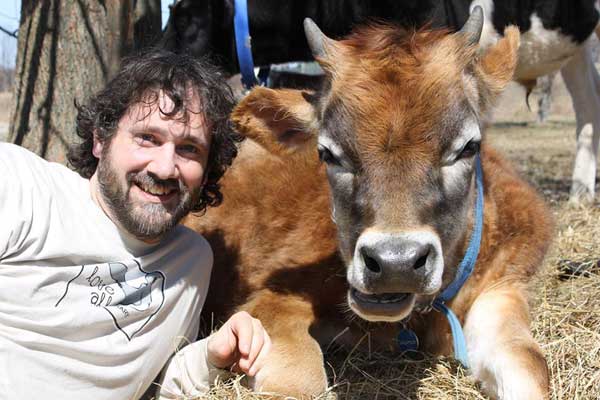
Keith and Jasper at Lasa Sanctuary
Beyond that, I’ll continue to find ways to use my voice to speak for a better world. I’ll write, draw, protest, table, and leaflet. I’ll continue to volunteer at Lasa Sanctuary where rescued farm animals come to know love instead of slaughter. I’ll continue to be a father, a son, and a friend, shedding my love on a world that desperately needs that from all of us. I imagine someday, I’ll even write a second book.
Many thanks to Keith Allison for stopping by and chatting with me. I’m incredibly inspired by people who stand with conviction in a kind and compassionate way. You can purchase his new book, What if the Shoe Were on the Other Hoof? right now on Blurb – just click here. The book is also available on Amazon.
Photos and artwork courtesy of the author (are copyrighted) and used with permission.

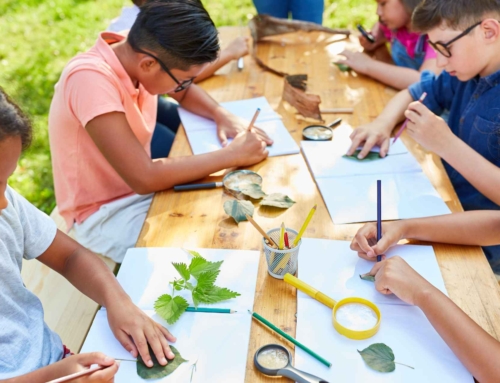
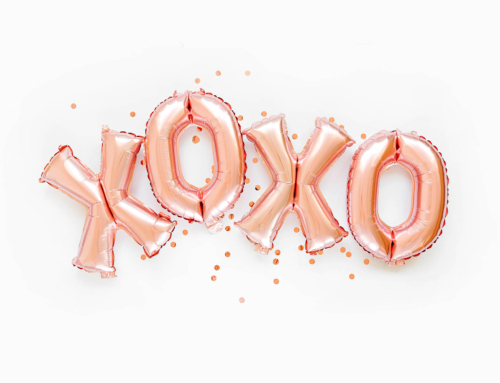
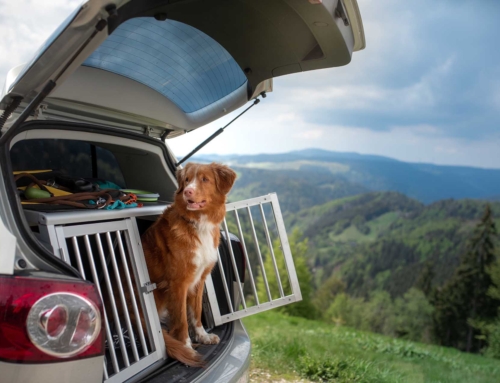
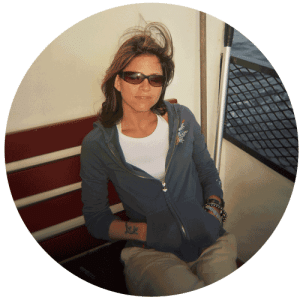

you know what’s messed up.. someone I know who was a teacher got fired for giving a kid of vegan parents a candy that had Gelatin in it.. Now that’s crossing a line cause he got fired for it even though the kid asked for it and NO ONE told him that he was vegain and honestly HOW MANY PEOPLE REALLY KNOW GELLTON IS MADE FROM ANIMAL PRODUCTS!!!!!! Like think jello, gummy bears and so on.. I know you or me may know but I think we both can honestly previce that most ppl dont.. hence every time I say what its made out of I get shocked faces from ppl I know. Now I’m vegan so I get it but using your kids as a political crusade or to force your own ideal on them when it can affect their health is nuts since kids need protein and without sublimation living both vegan and vegetarian in developmental years can have some harmful effects if your not aware of proper nutrition.
This made me so mad when I heard he got fired over it. Not to mention months later after the fact when the mom wanted to go out and complain about things long after the fact.. My friend may end up homeless because of this action since its so hard to get a job like that after having ‘fired” on their record.. this overly politically correct world is starting to make me since and I’M USUALLY ONE OF THE FIRST TO CHAMPION PEOPLES RIGHTS TO BE DIFFERENT AND LIVE HOW THEY CHOOSE AND BELIEVE WHAT THEY CHOOSE but c’mon…
people who are different can clearly be just as snobby, cold hearted, vindictive, and spiteful as anyone else.. not to mention self ritchus,, yes I admit objectively I have some slight bias in this subject since the person was my friend but I should clear up im not assuming the kids parents are any of those things I was just saying in as a matter of fact kind of way, cause what happened their is just a symptom of a much larger sociological disease sweeping our nation which is ” in effort to create more equality we start oppressing those who fit the previous norms”.. sometimes like that.
I should also note that when the teacher (my friend) learned of the kids veganism he apologised to the parents and said he would not repeat that mistake. they all seemed to accept the apology, only to bring it up again months later when its convenient. getting fired for something that happened long ago and was already dealt with is in ites self kind of messed up let alone the whole reason why over an honest mistake thats so easy to make in this new uppity world full of holier then tho hippocrates who have NO IDEA HOW HARD IT IS TO BE A TEACHER WITH KIDS THAT HAVE LESS DISCIPLINE AND PARENTS THAT SWOOP IN LIKE HAWKES OVER THE MOST PETTY RIDICULOUS THINGS.. seems the only way to be a successful teacher now – a – days is to be a drop dead gorgeous female that everyone else views until you can get 10 year.
Very inspiring, best wishes to Keith !
This is a great story, how truth is kept from us, and children too. The story has a happy ending. Often, those who oppose us lead us to greater things.
You’re an inspiration, Keith